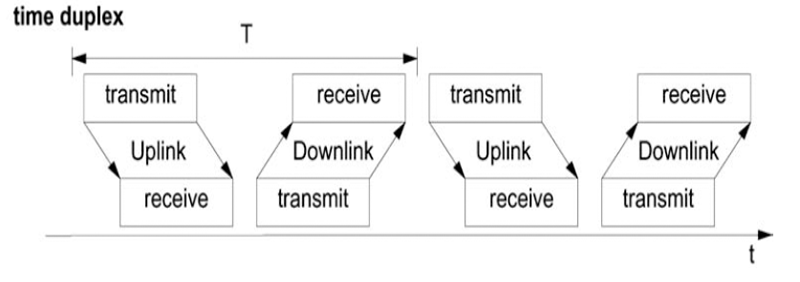The most frequent form of communication is the bidirectional communication which allows simultaneous transmitting and receiving. A system capable of doing this is called
full-duplex. One can also achieve full-duplex capability if sending and receiving do not occur simultaneously but switching between both phases is done so fast that it is not noticed by the user, i.e. both directions can be used quasi-simultaneously. Modern digital mobile radio systems are always full-duplex capable. Essentially, two basic duplex procedures are employed:
Frequency Division Duplex (FDD) using different frequency bands in each direction, and Time Division Duplex (TDD) which periodically switches the direction of transmission. Frequency Division Duplex (FDD)
The frequency duplex procedure has been used already in analog mobile radio systems and is also used in digital systems. For communication between a mobile and a base station, the available frequency band is split into two partial bands, to enable simultaneous sending and receiving. One partial band is assigned for uplink (from mobile to base station) transmissions and the other partial band is assigned for downlink (from base station to mobile) transmissions.
- Uplink band: transmission band of the mobile and receiving band of the base station
- Downlink band: receiving band of the mobile and transmission band of the base station.
To achieve good separation of both directions, the partial bands must be a sufficient frequency distance apart, i.e. the frequency pairs of a connection assigned to uplink and downlink must have this distance band between them. Usually, the same antenna is used for sending and receiving. A duplexing unit is then used for the directional separation, consisting essentially of two narrowband filters with steep flanks
 |
| Frequency Division Duplex |
Time Division Duplex (TDD)
Time duplexing is therefore a good alternative, especially in digital systems with time division multiple access. In this case, the transmitter and receiver operate only quasi simultaneously at different points in time, i.e. the directional separation is achieved by switching in time between transmission and reception, and thus no duplexing unit is required. Switching occurs frequently enough that the communication appears to be over a quasi simultaneous full-duplex connection. However, out of the periodic interval T available for the transmission of a time slot only a small part can be used, so that a time duplex system requires more than twice the bit rate of a frequency duplex system.
 |
| Time Division Duplex |

